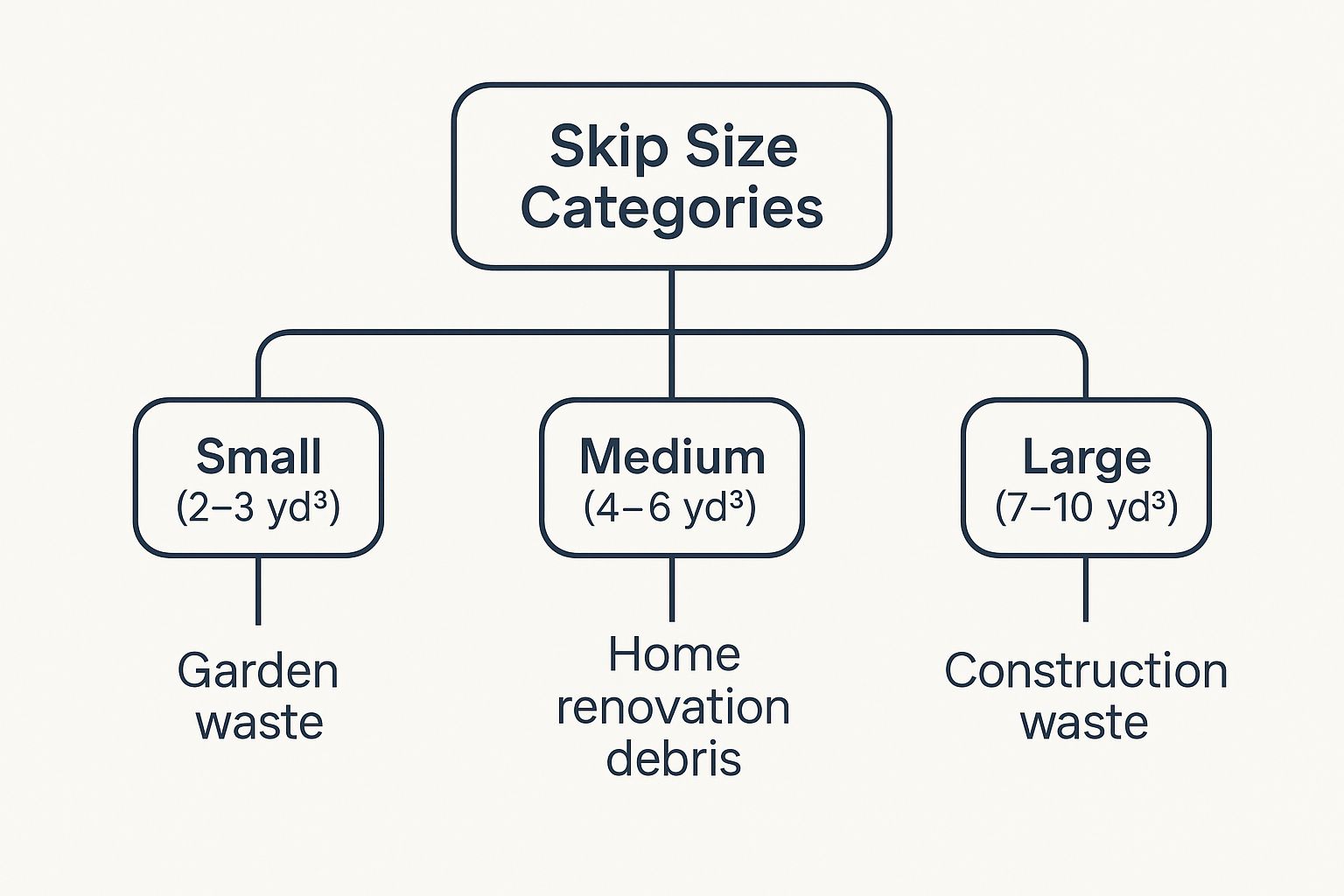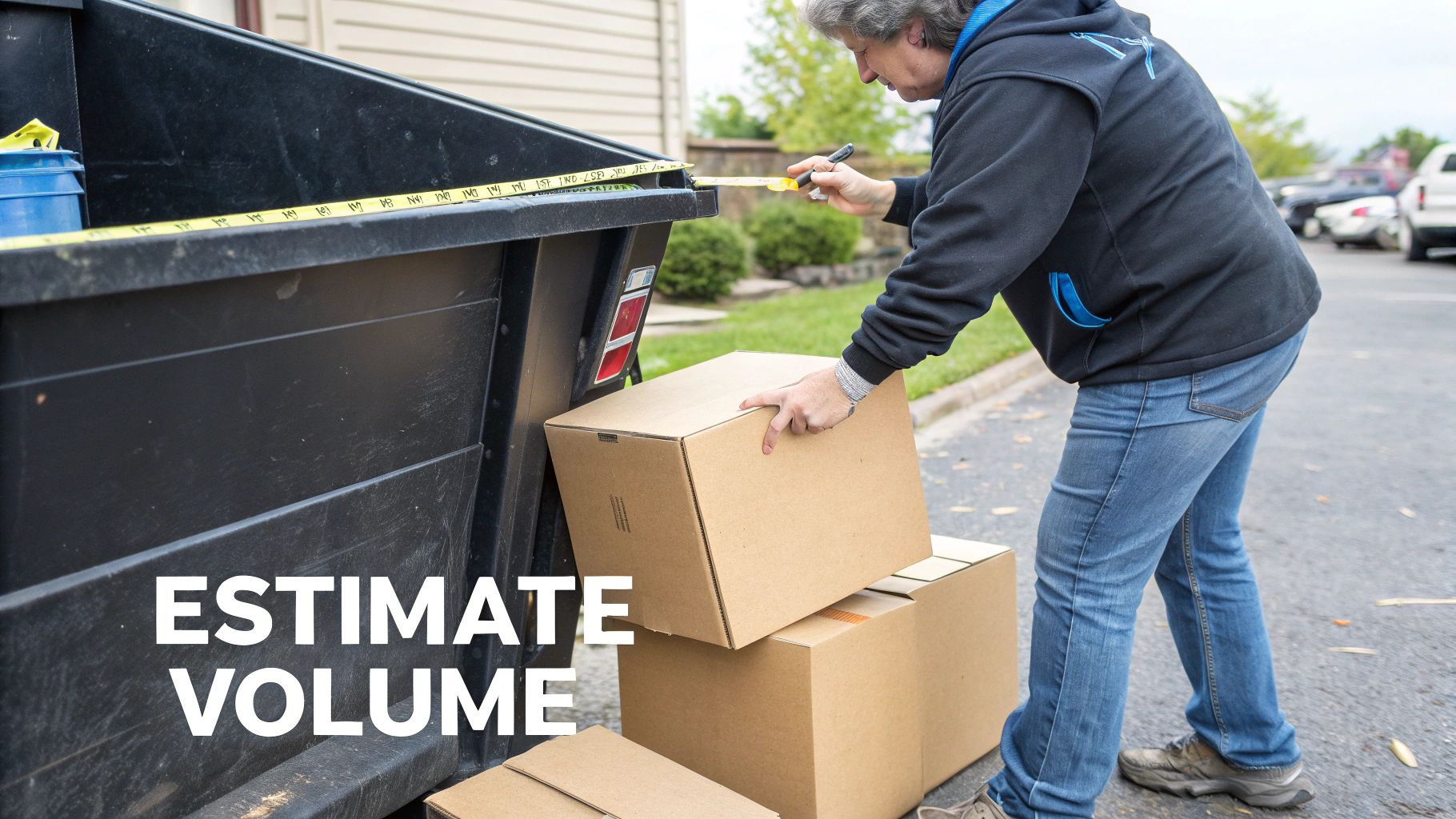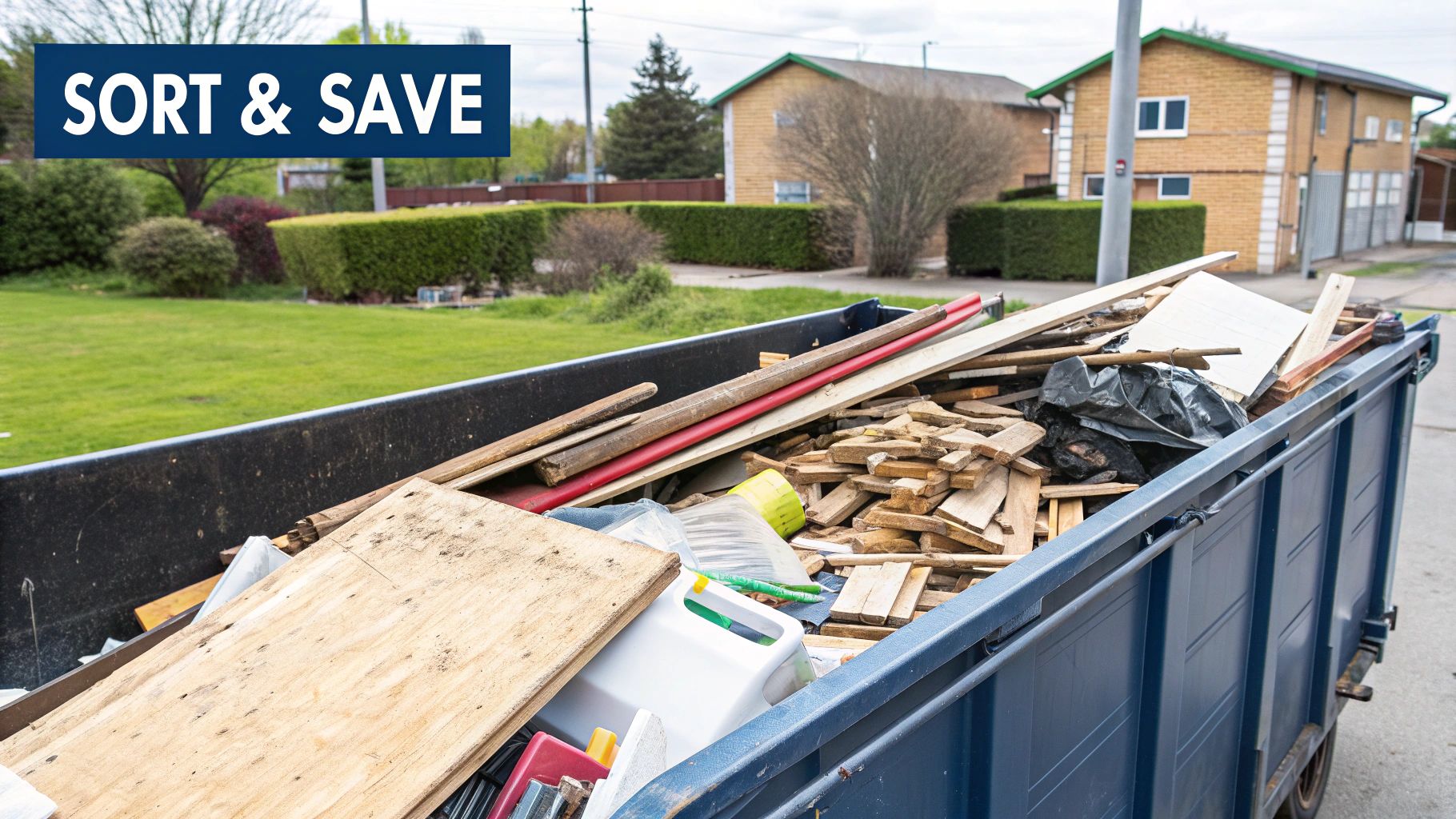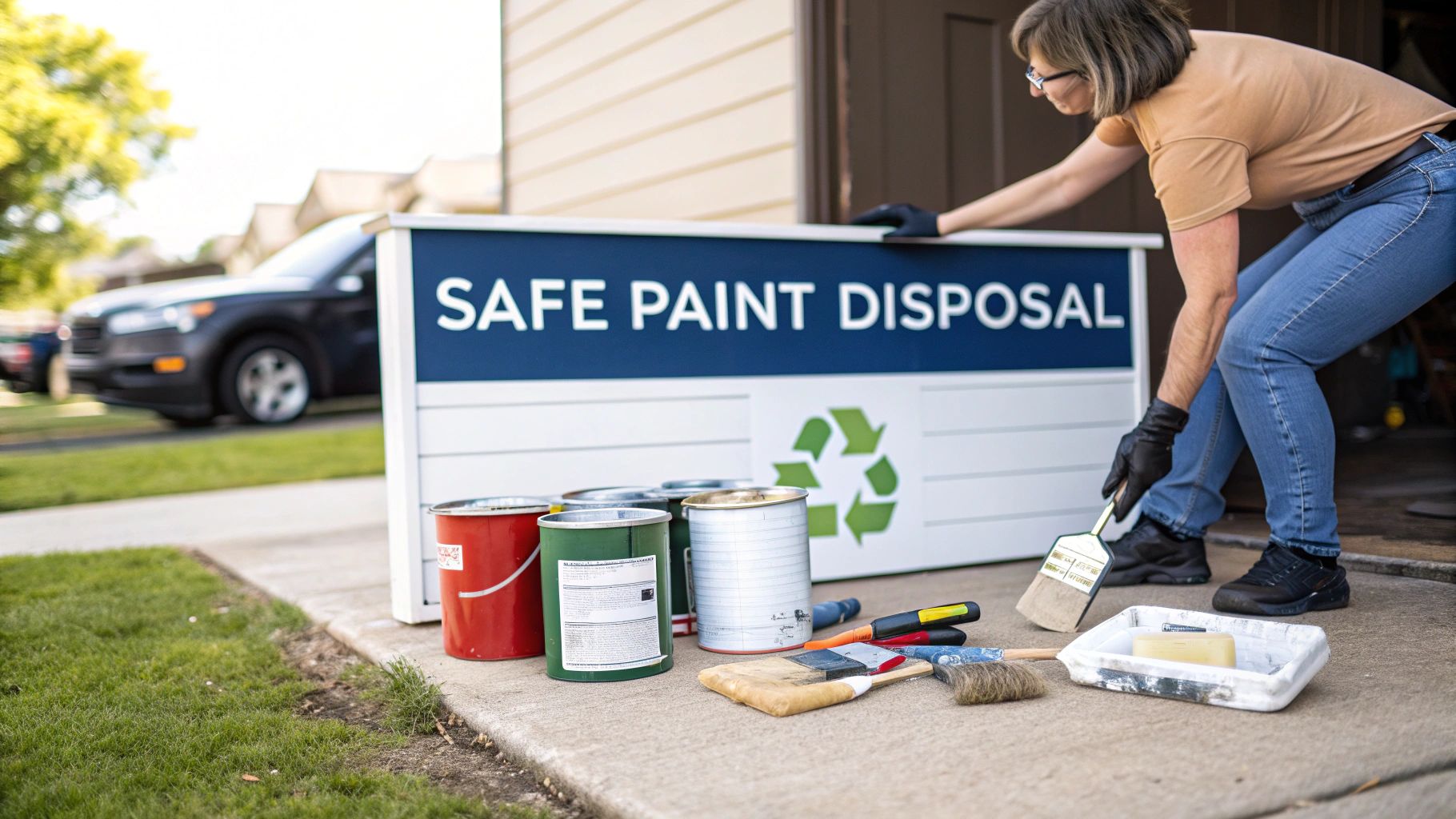What Size Skip Do I Need? A Complete UK Guide

What Size Skip Do I Need? Your Complete UK Guide
Here’s the rewritten section, designed to sound like it was written by an experienced human expert, following all the specified requirements.
Let’s be honest, picking the right skip size can feel like a bit of a guessing game. You don’t want to waste money paying for empty space, but you really don’t want the headache and extra cost of realising you need a second one halfway through the job. It’s the most common and costly mistake people make.
The trick is to stop thinking in abstract terms like ‘cubic yards’ and start visualising your actual waste.
What Size Skip Do I Need? A Quick Guide

Think of it like packing for a holiday. A quick weekend away just needs a small carry-on, but a two-week adventure abroad calls for a much bigger suitcase. It’s the same with waste. A small garden tidy-up will generate a lot less rubbish than a full kitchen renovation.
The golden rule? Picture all your waste piled up, then add about 20% more to your estimate. This is crucial because it accounts for all the awkward shapes and bulky items that don’t squash down, creating empty pockets of air you still have to pay for.
Top Tip: If you’re stuck between two sizes, always go for the larger one. The small price difference is nothing compared to the cost and hassle of hiring a second skip later on.
A Simple Guide to Common Skip Sizes
To make your decision easier, it helps to connect skip sizes to something you can easily picture, like the number of standard black bin bags they can hold. This simple mental conversion can take the guesswork right out of the equation.
For example, knowing a 4-yard skip holds roughly 40 bin bags makes it much simpler to judge if it’s big enough for that weekend decluttering project you’ve been planning. It’s a practical approach that gives you immediate confidence in your choice.
To help you get it right the first time, here’s a quick reference table. Use it to match common UK skip sizes to their capacity and the types of projects they’re perfect for.
Skip Size and Project Match-Up
| Skip Size (Cubic Yards) | Capacity in Bin Bags (Approx.) | Perfect For These Projects |
|---|---|---|
| 2-Yard ‘Mini’ Skip | 20-30 | Small garden clearances, single room declutters, minor DIY tasks. |
| 4-Yard ‘Midi’ Skip | 30-40 | Bathroom rip-outs, small kitchen refits, major garden clear-outs. |
| 6-Yard ‘Builder’s Skip’ | 50-60 | The most popular choice for general building work and home renovations. |
| 8-Yard ‘Large’ Skip | 70-80 | Ideal for full house clearances and larger construction projects. |
This table should give you a solid starting point for making a smart, cost-effective decision. Remember to consider not just the volume of your waste, but also its type – bulky furniture takes up more room than soil and rubble
Visualising UK Skip Sizes and Capacities
Trying to understand skip sizes in cubic yards can feel a bit like looking at a foreign currency. The numbers don’t mean much on their own, and it’s tough to know how they translate to your actual project. So, to really answer the question “what size skip do I need?”, it helps to think about it in terms of things you already know.
A great place to start is with standard black bin bags. It’s a simple comparison, but it instantly makes a skip’s capacity much clearer. A little 2-yard skip, for instance, holds around 20-30 bin bags. Suddenly, you can picture exactly how much that is, especially if you’re thinking about the rubbish from a weekend garden tidy-up.
This infographic is a handy visual guide, connecting the common skip sizes to the projects they’re best suited for.

As you can see, the scale of your project is the biggest factor, guiding you from a small skip for a garden job all the way up to a huge one for construction debris.
From Mini Skips to Maxi Skips
Let’s break down the most common sizes you’ll come across for domestic jobs here in the UK, starting small and working our way up. This should help you get a mental map of which container is the right fit.
- Mini Skips (2-3 Yards): These are the babies of the skip world, perfect for those minor clear-outs. Think of them as holding roughly 20-35 wheelbarrows of waste. They’re ideal for small DIY jobs or finally clearing out that packed garden shed.
- Midi Skips (4-6 Yards): This is the most popular range for household projects, and for good reason. A 4-yard skip is spot-on for a bathroom renovation, while the famous 6-yard “builder’s skip” is the go-to choice for kitchen refits or bigger clear-outs.
In the UK, skip sizes are measured in cubic yards, and a 6-yard skip holds about 50 to 60 bin bags of waste. This versatility makes it the top choice for countless home renovation projects. You can discover more insights about choosing the right skip size on TheWasteGroup.co.uk.
Considering Larger Project Needs
When your job is going to create a more serious amount of waste, you’ll need to look at larger containers. It’s almost always cheaper to get one big skip than to hire a smaller one multiple times.
- Large Skips (8-12 Yards): An 8-yard skip can handle around 80 bin bags, making it a solid choice for major household clearances or for getting rid of bulky waste from a home extension. The even bigger 12-yard skip is generally reserved for significant building projects where you have a mix of large but lightweight materials.
By picturing these capacities next to familiar things like bin bags and wheelbarrows, you can move past the guesswork. Taking this practical approach ensures you hire a skip that perfectly matches what you need, saving you both time and money in the long run.
Matching Your Project to the Perfect Skip

The best way to pick the right skip is to forget about abstract dimensions for a moment and think about the job you’ve actually got in front of you. When you connect your task to real-world examples, all the guesswork disappears, leaving you with the most sensible and cost-effective choice.
Let’s walk through some common UK projects and give some straight-talking recommendations for each. This helps you avoid those classic costly mistakes, like ordering a skip that’s too small and needing another, or paying for empty space you just didn’t need.
Don’t forget to think about the type of waste you’re producing, too. Not everything is allowed in a general skip, so it’s always worth a quick check. To be absolutely sure, take a look at our simple guide on what can go in a skip.
Common DIY Projects and Skip Recommendations
For those smaller jobs around the house and garden, a compact skip is often all you need. They’re much easier to fit onto a drive and are brilliant for focused clear-outs that produce either dense, heavy waste or a moderate amount of bulkier bits and bobs.
The 4-yard ‘Midi’ skip is the undisputed champion for projects like:
- Clearing out a garden shed or a small loft space.
- A full bathroom refurbishment, including tiles and the old suite.
- Getting rid of soil and rubble from a landscaping job.
Managing waste effectively is crucial for any major undertaking. You can find some great tips for handling your home renovations and remodelling projects.
When you’re stepping up to larger-scale renovations that will create a real mix of waste – think old kitchen units, flooring, and plasterboard – you’ll need to size up your skip accordingly.
This is where an 8-yard skip becomes essential. If a midi skip just won’t cut it, this is your go-to. It’s the perfect size for a major kitchen overhaul, a small home extension, or even a full house clearance.
Looking at the data, most domestic projects in the UK end up using either a 4 or 6-yard skip. It’s the sweet spot that balances decent capacity with the flexibility to place it easily.
The 6-yard skip, which can hold about 60 bin bags‘ worth of rubbish, is the most popular size hired by UK homeowners, with prices starting from around £195. For the vast majority of home projects, a skip this size will see you right.
Right, so you’ve worked out what size skip you need. That’s a great start, but getting the right size is only half the battle. A bit of extra planning now will save you a world of headaches when it comes to delivery and collection.

The most common snag people hit is site access. Before you book, take a proper look at your property. Can a big, heavy lorry actually get to your driveway or the spot where you want the skip?
Get a tape measure out. Check the width of your gate and drive, and keep an eye out for tight corners, low-hanging tree branches, or even parked cars that could get in the way. Trust me, those lorries need more room to manoeuvre than you might think.
Waste and Permit Logistics
Next up, you need to be crystal clear on waste restrictions. You can’t just chuck everything and the kitchen sink into a general waste skip. Some materials are a definite no-go, while others need to be handled separately.
Commonly restricted items include:
- Plasterboard (this nearly always needs to be bagged up on its own)
- Mattresses and any upholstered seating
- Electrical items (like old TVs, microwaves, or fridges)
- Hazardous materials (think paint, solvents, asbestos)
- Tyres and gas canisters
Always double-check what’s allowed with your hire company. A quick chat can save you from a nasty surprise, like extra fines or the driver refusing to collect the skip. It’s a simple check that keeps your project running smoothly and on budget.
A crucial detail many people forget is the potential need for a council permit. If the skip can’t fit on your private land (like a driveway or garden) and has to go on a public road or pavement, a permit isn’t optional—it’s a legal requirement.
Getting a permit takes a bit of time, so don’t leave it to the last minute. Your skip hire company can usually sort this out for you, but it will add to the final bill. For a full breakdown, have a look at our guide on how much it is to hire a skip, which covers these extra costs.
Thinking these details through beforehand makes the whole experience completely stress-free.
Common Skip Hire Mistakes That Cost You Money

A few simple, easy-to-avoid mistakes can quickly turn a straightforward skip hire into a costly headache. Knowing the common traps means you can sidestep them, keeping your project running smoothly and, most importantly, on budget.
The biggest slip-up we see is underestimating the amount of waste you have. When you’re staring at a room full of clutter or a garden that needs clearing, it’s tempting to hedge your bets and go for the smaller, cheaper skip. But this often backfires. Having to order a second skip is always more expensive than hiring one, slightly larger skip from the get-go.
Overfilling and Prohibited Items
Another critical error is overfilling your skip. Every single skip has a ‘level load’ line clearly marked on its side for a reason. Piling waste high above this line isn’t just unsafe for transport; it’s actually illegal. Your driver will have no choice but to refuse collection, leaving you with the messy job of unloading all the excess waste yourself.
Tossing prohibited items into your skip is another frequent and expensive mistake. Things like electronics, tyres, paint, and plasterboard can’t be mixed with general waste. They require special disposal, and you’ll face penalties if they’re found in your skip.
Finally, don’t fall into the trap of thinking all skip hire services are the same. A bargain price might catch your eye, but it’s vital to remember that the lowest price is not always best when it comes to skip hire. Service quality, reliability, and hidden charges can vary massively between companies.
By steering clear of these common mistakes, you can make sure your waste disposal is efficient, legal, and doesn’t end up costing you more than it should.
Your Skip Hire Questions, Answered
Planning a project is one thing, but dealing with the waste it creates is another. It’s natural to have a few questions, especially if it’s your first time hiring a skip. Getting clear, simple answers from the start makes the whole process smoother. Here are the most common queries we get, with some straightforward advice.
What Happens If I Order a Skip That Is Too Small?
This is a classic trap and, unfortunately, can be a costly mistake. If you fill your skip but still have a pile of rubbish left over, your only real option is to hire a second one. This nearly always works out to be more expensive than just ordering a slightly larger skip in the first place.
Keep in mind that skip companies are legally forbidden from transporting an overfilled skip. They can’t just take the excess off the top and promise to come back later. If you’re on the fence about what size you need, it’s always smarter to go one size up.
Do I Need a Permit to Put a Skip on My Driveway?
Good news – no, you won’t need to get a permit from the council if the skip is placed entirely on your own private land, like a driveway or front garden.
Permits only come into play when the skip has to sit on public property, such as the road or a pavement outside your house. Your skip hire company can usually sort the permit out for you, but it adds to the cost and can take a few days to process, so be sure to plan ahead if you need one.
A Quick Word on Waste Types: You can generally mix standard household and construction waste. However, there’s a strict ‘no’ list that includes hazardous materials like asbestos, chemicals, and paint. Electricals, tyres, and gas canisters are also forbidden. Plasterboard is another one to watch – it must be kept separate so it doesn’t contaminate the rest of the load. It’s always best to double-check the prohibited items list with your hire company to avoid any fines or a refusal to collect.
A final check on these points will help you sidestep any unexpected problems and keep your project on track and on budget.
Article created using Outrank

